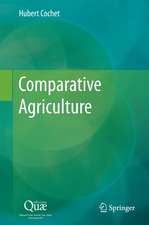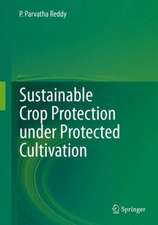Integration of Insect-Resistant Genetically Modified Crops within IPM Programs: Progress in Biological Control, cartea 5
Editat de Jörg Romeis, Anthony M. Shelton, George Kennedyen Limba Engleză Paperback – 21 iul 2008
| Toate formatele și edițiile | Preț | Express |
|---|---|---|
| Paperback (1) | 653.14 lei 43-57 zile | |
| SPRINGER NETHERLANDS – 21 iul 2008 | 653.14 lei 43-57 zile | |
| Hardback (1) | 658.05 lei 43-57 zile | |
| SPRINGER NETHERLANDS – 31 iul 2008 | 658.05 lei 43-57 zile |
Din seria Progress in Biological Control
- 18%
 Preț: 952.57 lei
Preț: 952.57 lei - 18%
 Preț: 1222.01 lei
Preț: 1222.01 lei - 18%
 Preț: 1381.58 lei
Preț: 1381.58 lei - 18%
 Preț: 955.25 lei
Preț: 955.25 lei - 18%
 Preț: 956.33 lei
Preț: 956.33 lei - 15%
 Preț: 632.19 lei
Preț: 632.19 lei - 24%
 Preț: 1054.21 lei
Preț: 1054.21 lei - 15%
 Preț: 657.25 lei
Preț: 657.25 lei - 15%
 Preț: 649.06 lei
Preț: 649.06 lei - 18%
 Preț: 1412.20 lei
Preț: 1412.20 lei - 18%
 Preț: 942.76 lei
Preț: 942.76 lei - 24%
 Preț: 797.37 lei
Preț: 797.37 lei - 18%
 Preț: 1117.03 lei
Preț: 1117.03 lei - 18%
 Preț: 948.16 lei
Preț: 948.16 lei - 15%
 Preț: 652.17 lei
Preț: 652.17 lei - 18%
 Preț: 956.81 lei
Preț: 956.81 lei - 18%
 Preț: 1234.77 lei
Preț: 1234.77 lei - 18%
 Preț: 936.29 lei
Preț: 936.29 lei - 18%
 Preț: 1225.94 lei
Preț: 1225.94 lei
Preț: 653.14 lei
Preț vechi: 768.40 lei
-15% Nou
Puncte Express: 980
Preț estimativ în valută:
124.98€ • 130.82$ • 104.02£
124.98€ • 130.82$ • 104.02£
Carte tipărită la comandă
Livrare economică 31 martie-14 aprilie
Preluare comenzi: 021 569.72.76
Specificații
ISBN-13: 9781402084591
ISBN-10: 1402084595
Pagini: 464
Ilustrații: XVIII, 441 p.
Dimensiuni: 155 x 235 x 19 mm
Greutate: 0.77 kg
Ediția:2008
Editura: SPRINGER NETHERLANDS
Colecția Springer
Seria Progress in Biological Control
Locul publicării:Dordrecht, Netherlands
ISBN-10: 1402084595
Pagini: 464
Ilustrații: XVIII, 441 p.
Dimensiuni: 155 x 235 x 19 mm
Greutate: 0.77 kg
Ediția:2008
Editura: SPRINGER NETHERLANDS
Colecția Springer
Seria Progress in Biological Control
Locul publicării:Dordrecht, Netherlands
Public țintă
Professional/practitionerCuprins
Integration of Insect-Resistant Genetically Modified Crops within IPM Programs.- How Governmental Regulation Can Help or Hinder the Integration of Bt Crops within IPM Programs.- Insecticidal Genetically Modified Crops and Insect Resistance Management (IRM).- Insect-Resistant Transgenic Crops and Biological Control.- The Present and Future Role of Insect-Resistant Genetically Modified Maize in IPM.- The Present and Future Role of Insect-Resistant Genetically Modified Cotton in IPM.- The Present and Future Role of Insect-Resistant Genetically Modified Potato Cultivars in IPM.- Bt Rice in Asia: Potential Benefits, Impact, and Sustainability.- Transgenic Vegetables and Fruits for Control of Insects and Insect-Vectored Pathogens.- Landscape Effects of Insect-Resistant Genetically Modified Crops.- Have Bt Crops Led to Changes in Insecticide Use Patterns and Impacted IPM?.- Economic and Social Considerations in the Adoption of Bt Crops.- Beyond Bt: Alternative Strategies for Insect-ResistantGenetically Modified Crops.- IPM and Insect-Protected Transgenic Plants: Thoughts for the Future.
Recenzii
From the reviews:
"The book has 14 Chapters contributed by 42 authors. … Each chapter is supported by an extensive list of references. This excellent book will surely contribute to a rational debate about the role of GM technology in crop production when a growing human population is demanding an improvement in food production. It should be read by all those involved in the debate … ." (Graham Matthews, Crop Protection, Issue 1, 2008)
"The book has 14 Chapters contributed by 42 authors. … Each chapter is supported by an extensive list of references. This excellent book will surely contribute to a rational debate about the role of GM technology in crop production when a growing human population is demanding an improvement in food production. It should be read by all those involved in the debate … ." (Graham Matthews, Crop Protection, Issue 1, 2008)
Textul de pe ultima copertă
Insect pests remain one of the main constraints to food and fiber production worldwide despite farmers deploying a range of techniques to protect their crops. Modern pest control is guided by the principles of integrated pest management (IPM) with pest resistant germplasm being an important part of the foundation. Since 1996, when the first genetically modified (GM) insect-resistant maize variety was commercialized in the USA, the area planted to insect-resistant GM varieties has grown dramatically, representing the fastest adoption rate of any agricultural technology in human history. The goal of our book is to provide an overview on the role insect-resistant GM plants play in different crop systems worldwide. We hope that the book will contribute to a more rational debate about the role GM crops can play in IPM for food and fiber production.
Caracteristici
The first comprehensive synthesis of the development, adoption, regulation and impact of insect-resistant GM plants for crop protection and their effect on IPM programs Comprised of multi-authored chapters and has an international perspective Provides a state-of-the-art summary of the worldwide use of this technology and its impacts


























